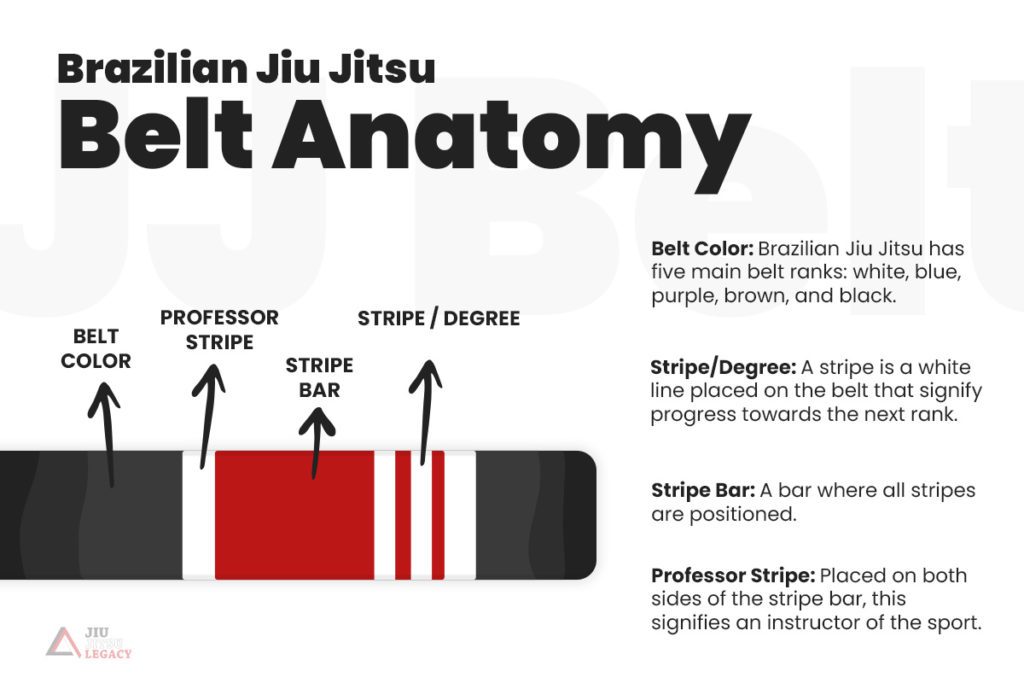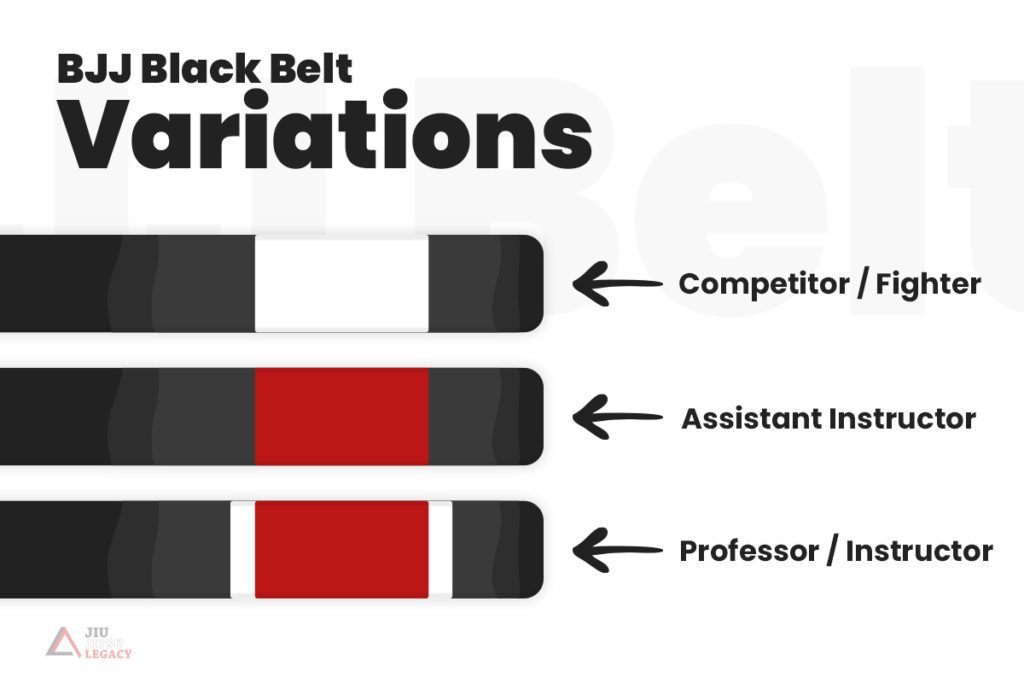Synonymous with martial arts is the idea of belt ranks. When you tell someone you train Brazilian Jiu Jitsu the first thing they will picture is someone in a gi with a belt tied around their waist. Alternatively, they might reply unhelpfully: “Wow, my friend does UFC!”
You might worry that people will think it’s silly if you tell them you’re a white or blue belt – and you might worry they’re right. However, BJJ belt rankings are widely regarded to actually mean something. But what exactly do they mean? You also might be wondering about the mythical red belt. Is it even a real rank? This is the complete guide to everything you need to know about BJJ belts and their meaning.
The Five Main BJJ Belt Ranks
Brazilian Jiu Jitsu has five main belt ranks: white, blue, purple, brown, and black. Everyone starts at white, and very few ultimately make it to black. We’ve broken down each belt for you so you have an idea of what each belt rank signifies. Keep in mind that BJJ belts are not standardized, and your gym may have its own expectations and requirements.
White Belt
You might’ve come across videos online that are all about how to survive your first few months of training as a BJJ white belt. While some white belts have prior grappling experience, like wrestling, most people stepping onto the mat for the first time have none and will need to learn everything from the ground up! After learning how to tie your belt, white belts should focus on learning to survive.
Surviving might be a more apt term than most people realize because most white belts will quit!
It can be demoralizing stepping onto the mat just to be crushed again and again, especially if you are being submitted by someone smaller than you. But don’t fret, most new practitioners face this problem. Being submitted by someone who is smaller than you is evidence of how effective training BJJ can be.
As a white belt you don’t always need to win. What you should focus on is how to become comfortable with the pressure that is applied during sparring (rolling). Instead of focusing on submitting your opponent you can just focus on hitting what you learned in class that day. Count your roll a success if you hit a sweep, maintain a position, or escape a bad position.
Blue Belt
The definition of blue belt according to Helio Gracie is “someone who is able to submit a larger untrained opponent,” and this is the definition most BJJ coaches follow. Blue belts are often able to roll with brand new white belts with ease. Most practitioners are awarded a blue belt after two years of consistent training. The International Brazilian Jiu Jitsu Federation (IBJJF) has set the minimum age for blue belt at 16 years of age.
You will often hear Blue belt referred to as “the buffet belt.” This is because blue belt is where you will start picking up new techniques and seeing which you like. You will notice that there are different styles of Jiu Jitsu. Some more advanced practitioners might have a pressure passing game, while others are happier pulling guard.
Unfortunately, like white belts, blue belts have a reputation of never coming back to the gym. This can be for a multitude of reasons. The first and foremost is after two years of training, the road to black belt might seem like an insurmountable challenge. Another reason is even though you feel comfortable rolling with white and blue belts, you still might be crushed by purple belts.
Purple Belt
According to Firas Zahabi, a BJJ black belt under John Danaher, purple belt is the first advanced rank in BJJ. Purple belts should be to blue belts as blue belts are to white belts. Purple belts can be an excellent source of information to show white belts basic techniques. At your gym the purple belt might be the “mat enforcer.”
This is also regarded as the rank where you start developing your game – or the style of BJJ you do in competition. Most purple belts have learned the basics of BJJ and can start chaining together techniques. You also might be surprised to learn that many practitioners who receive a purple belt go on to receive their black belt.
If you are looking to compete at purple belt, the IBJJF requires you spend a minimum of two years at blue belt and be at least 16 years old. This is why if you are looking to compete, it would be a good idea to register with the IBJJF as soon as possible. Many of the highest ranking Jiu Jitsu athletes compete at IBJJF tournaments.
Brown Belt
The IBJJF requires practitioners to spend eighteen months at purple belt before progressing to brown belt, and they also must be at least 17 years old. Brown belts should have their game refined at this level. This belt is also about spending time perfecting the areas of Jiu Jitsu you’re not quite as familiar with.
Competing at brown belt can be intimidating because this is the rank where the IBJJF allows moves like heel hooks, and reaping. Many BJJ gyms teach guard passing before leg locks. Competitors should be comfortable training both leg attacks and defenses before registering for competition.
Black Belt
On average, it takes ten years to reach the coveted rank of black belt. (Although people like BJ Penn have reached it much quicker.) The rank of black belt gives you real authority within a gym. People come to you with questions about both basic and complicated techniques. This is described as the “heaviest” belt to carry.
Many instructors only like to award black belts to people who they think have a high moral character. In Brazil, people who earn a blackbelt are commonly referred to as “professor.” The first three stripes take three years each to be awarded. The 4th, 5th, and 6th each require spending 5 years at the former rank.
The IBJJF standard requires a person to be 19 years of age or older. Further, the IBJJF only recognizes athletes who have been an IBJJF registered brown belt for a year. Additionally, in order to be an IBJJF registered black belt, you must complete a CPR and referee course.
Some of these requirements have led to controversies within the BJJ community. Accomplished competitors like Robert Degle and Mica Galvo aren’t recognized as Degle did not spend sufficient time as a registered brown belt and Mica (despite his competition success) is too young according to the IBJJF.
What lies beyond black belt?
Although they are not listed above, the Red and Coral belt ranks are real; they are even IBJJF recognized. These ranks come with titles “Master” and “Grand Master”. Currently, there are only 19 recognized IBJJF red belts; most of whom are in the Gracie family. Yvonne Duarte became the first woman to receive a red belt in August 2021.
Red and Black (Coral) Belt
After the 6th degree on a black belt, plus an additional seven years of training, a practitioner is eligible for a red and black belt. To be eligible for a red and black belt, you must have been awarded your black belt 31 years prior.
Red and White (Coral) Belt
The more degrees a practitioner receives, the longer it takes them to attain. While it only takes seven years to receive a red and black belt, it takes ten years to receive a red and white belt. This is the final rank someone receives before they become eligible for a full red belt. Currently, there are only 24 IBJJF registered red and white belts.
Red Belt
The full red belt is awarded at the ninth degree. The 10th degree is currently only held by founding Gracie family members. According to Renzo Gracie, a red belt is someone whose “influence and fame takes them to the pinnacle of the art.” For all intents and purposes, don’t focus too much on trying to attain this belt, as a majority of it is simply time spent training.
Tips for Ranking Up in BJJ
Get a Notebook
BJJ is a complicated martial art. Many of the techniques have small steps that have to be done in a precise manner. Sometimes being in class can feel like an information overload. Writing down what you remember from class can help you to retain the information you learn.
Keep showing up
It’s 90% of life, and also the best way to get better at Jiu Jitsu. Don’t become a statistic like so many white and blue belts.
Don’t worry so much about the belt ranks
It’s easy to motivate yourself with the idea of reaching the next level. However, keep in mind that the belt is not always the best indicator of actual ability. In class focus on perfecting the techniques.
FAQs
How do you progress to the next rank in BJJ?
You progress to the next rank in BJJ by consistent training and dedication. Brazilian Jiu Jitsu is one of the few martial arts where it is considered more difficult to progress in belt ranks, compared to other martial arts. Generally, coaches award ranks when they feel students are ready, rather than following a rigid promotion schedule.
Who can give out promotions in BJJ?
Only black belts may award promotions (except in countries where there are too few black belts to encourage the development of the sport). Only black belts with a minimum of 2 stripes may award black belts. In countries where ranks below black belt may award rank, coaches may only promote to the belt below their own (brown to purple, purple to blue).
How many belts are there in BJJ?
There are five main belt ranks in BJJ, not including the coral and red belts. Although there are only five, on average it takes ten years to progress through the ranks.
How many BJJ black belts are there in the world?
You can actually go on the IBJJF website and see the names and academy’s of certified black belts. Currently, there are roughly 6,000 IBJJF registered black belts. However, a large number of black belts are not registered with the IBJJF because it’s expensive and a time commitment to register with them.
Do you have to pay for belts or promotions?
No, you should never have to pay for belt promotions (aside from gym dues). Gyms that let you pay for a promotion are jokingly referred to as “McDojos.” If you find a gym that lets you do this, it would be wise to avoid them, as they have a reputation for not teaching good technique.
Does your belt rank matter?
Yes and no. The belt can be a wonderful goal to set for yourself to achieve. However, there are many people who don’t get promoted because they frequently move gyms and there are many people that are much more skilled than the belt they wear. Likewise, there are some people that carry a belt that they aren’t quite skilled enough to have.
What do stripes on your Jiu Jitsu belt signify?
Stripes signify progress towards the next rank. Someone receives four stripes before they get promoted. On a black belt, they signify the degree of black belt. Not all gyms use stripes, talk to your coach about how he measures progress.
Are Jiu Jitsu Belt Ranks standardized?
Yes/No/Sort of. Although the IBJJF markets themselves as the governing body of Jiu Jitsu but they are not. Many gyms adhere to these guidelines because you have to in order to compete with the IBJJF. Recently a 17-year-old was promoted to black belt even though the IBJJF age limit is 19.
What is a “Sand Bagger”?
If you are looking to compete in BJJ, then at some point you will run into a sandbagger. A sandbagger is someone who is more skilled than their belt rank. You might’ve seen a picture online of UFC star Khabib Nurmagomedov walking into a competition wearing a incorrectly tied white belt. Sometimes coaches hold their students back, so they can do well in competitions.
Conclusion
Brazilian Jiu Jitsu black belts are held in high esteem within the martial arts community, largely because of how long it takes to get one. With diligent training you are able to receive a black belt much quicker in other major martial arts. Although some members of the BJJ community see the belt system as dated, they are a part of the sport and martial arts culture.
Jack is a D who holds a bachelors degree in English Literature. He enjoys traveling, reading, and the Bow and Arrow choke. One day he hopes to teach English overseas and become a published author.











